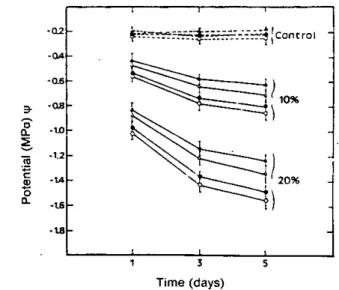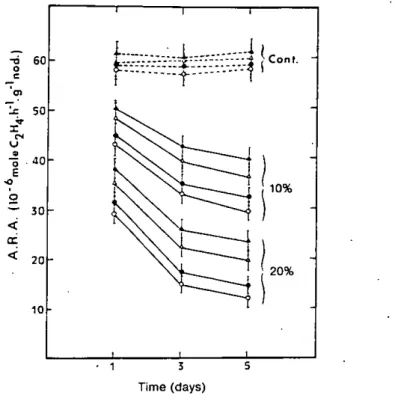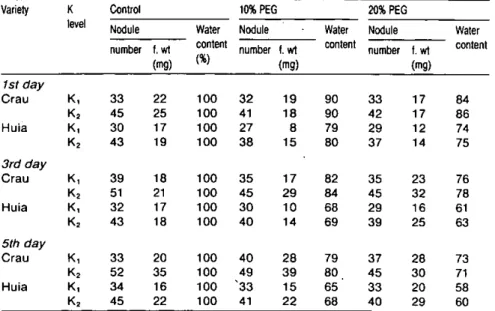HAL Id: hal-02709868
https://hal.inrae.fr/hal-02709868
Submitted on 1 Jun 2020
HAL is a multi-disciplinary open access
archive for the deposit and dissemination of sci-entific research documents, whether they are pub-lished or not. The documents may come from teaching and research institutions in France or abroad, or from public or private research centers.
L’archive ouverte pluridisciplinaire HAL, est destinée au dépôt et à la diffusion de documents scientifiques de niveau recherche, publiés ou non, émanant des établissements d’enseignement et de recherche français ou étrangers, des laboratoires publics ou privés.
Effect of potassium on the tolerance to PEG induced
water stress of two white clover varieties (Trifolium
repens L.)
Christophe Robin, L. Shamsun-Noor, Armand Guckert
To cite this version:
Christophe Robin, L. Shamsun-Noor, Armand Guckert. Effect of potassium on the tolerance to PEG induced water stress of two white clover varieties (Trifolium repens L.). Potash Review, 1991, pp.1-4. �hal-02709868�
Publisher: International Potash Institute, CH-3048 Worblaufen-Bern/ Switzerland Phone 31/58 53 73, Telex 912 091 ipi ch, Fax 31/58 4129
Subject 2
No.
2/1991
Plant physiology, plant analysis
9th suite
Effect of potassium on the tolerance to PEG induced
water stress of two white clover varieties (Trifolium
repens L.)
Robin, C., Shamsun-Noor, L. and Guckert, A.
Laboratoire de Phytotechnie - I.NR.A., E.N.S.A.I.A., 2, avenue de la Forft de Haye, B.P. 172, F-54505 Vandceuvre-les-Nancy Cedex, France Extended abstract of a paper published in Plant and Soil 120, 153-158
(1989)
The paper describes the results of an experiment in which two varieties of white clover, Crau and Huia, were grown hydroponically at two levels of potassium supply (K1=0.005 mM and K2=5 mM), unstressed and with water stress induced by polyethylene glycol (PEG) at two levels: 10% PEG and 20%
PEG w/v. Treatments were applied to 2 month old seedlings and the duration
of the experiment was 5 days.
The following measurements were made at day 1, day 3 and day 5:
Pre-dawn leaf water potential (Figure 1), Stomatal resistance (Figure 2),
Nitrogen fixation capacity(Figure 3) by acetylene reduction activity (ARA), Nodule number, fresh weight and water content (Table 1).
Pre-dawn water potential and ARA of unstressed plants remained con-stant but those of stressed plants declined, more markedly to day 3 than later. The ill effects of stress were less marked with Crau than with Huia and the effect of potassium in countering stress was evident. Stomatal resistance remained virtually constant in unstressed plants but increased during the course of the experiment in stressed plants with a marked difference between varieties, Crau again showing better performance than Huia. ARA was positively correlated with leaf water potential (0.86<r<0.92) and nega-tively with stomatal conductance (-0.85<r<-0.89).
-a4 10% - -12 1.2 --IA 20% 1 3 s Time (days)
Figure 1 Dawn water potentials (bars) of the 2 varieties of white clover (Crau and Huia) during the osmotic stress induced by PEG (0, 10 and 20%) under 2 levels of K:
K, =0-005 and K,=5 mM. A Crau K,; A, Crau K; 0 Huia K2; 0 Huia K,.
30- 25-2 120% * 20 c I - I 5 - .... ... . .- --- -. .. . Cont• I I
I
1 3 s Time (days)Figure 2 Stomatal resistance of the 2 varieties during the osmotic stress induced by
PEG (0 and 20%) under 2 levels of K: K1 =0.005 and K2=5 MaM. A Crau K2; iS Crau K,; 0 Huia K2; 0 Huia K,.
2/9 I - I-Cont. -o -5u -
0--
---0 40% 1 0 20-1 3 5 Time (days)
Figure 3 Nitrogen fixation N2 (acetylene reduction activity) of the 2 varieties during the osmotic stress induced by PEG (0, 10 and 20%) under 2 levels of K: K, =0.005 and
K2 =5 raM. A Crau K2; A Crau K,; 0 Huia K,; 0 Hula K,.
Table I shows difference between varieties in favour of Crau which also had the better leaf and root development. Nodule mass was reduced by water e stress The effect of K was to increase nodule mass and to lessen the damag-ing effect of increasdamag-ing water stress, the effect of water stress in lowerdamag-ing nodule water content being reduced by adding K.
The beneficial effects of potassium on leaf water status, stomatal activity and osmotic processes in plants are well-known, and these results show clearly that it is an essential factor determining resistance to water stress in white clover.
Osmotic stress caused a rapid decrease in IN fixation while a shortage of K aggravated this effect. The work confirms earlier findings that white clover varieties differ in their resistance to water stress and also shows that varietal resistance to water stress is reinforced by high potassium supply.
Table I Nodule mass (g.plant-1), nodule number (per plant) and nodule water con-tent (% of the controls)
Variety K Control 10% PEG 20% PEG
level Nodule Water Nodule Water Nodule Water number f w content number 1. wt content number f. wt content
(mg) (%) (mg) (mg) 1st day Crau K, 33 22 100 32 19 90 33 17 84 K2 45 25 100 41 18 90 42 17 86 Hula K, 30 17 100 27 8 79 29 12 74 K, 43 19 100 38 15 80 37 14 75 3rd day Crau K, 39 18 100 35 17 82 35 23 76 K2 51 21 100 45 29 84 45 32 78 Huia K, 32 17 100 30 10 68 29 16 61 K2 43 18 100 40 14 69 39 25 63 5th day Crau K, 33 20 100 40 28 79 37 28 73 K2 52 35 100 49 39 80 45 30 71 Huia K, 34 16 100 '33 15 65 33 20 58 K2 45 22 100 41 22 68 40 29 60


